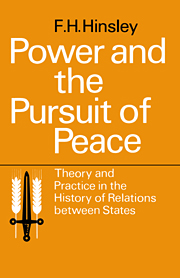Book contents
- Frontmatter
- Contents
- INTRODUCTION
- PART I A HISTORY OF INTERNATIONALIST THEORIES
- 1 To the End of the Seventeenth Century
- 2 Penn, Bellers and Saint-Pierre
- 3 Rousseau
- 4 Kant
- 5 Bentham and James Mill
- 6 The First Half of the Nineteenth Century
- 7 From the Crimean War to the League of Nations
- PART II A HISTORY OF THE MODERN STATES' SYSTEM TO 1900
- PART III INTERNATIONAL RELATIONS AND INTERNATIONAL ORGANIZATIONS IN THE TWENTIETH CENTURY
- References
- Index
7 - From the Crimean War to the League of Nations
Published online by Cambridge University Press: 11 January 2010
- Frontmatter
- Contents
- INTRODUCTION
- PART I A HISTORY OF INTERNATIONALIST THEORIES
- 1 To the End of the Seventeenth Century
- 2 Penn, Bellers and Saint-Pierre
- 3 Rousseau
- 4 Kant
- 5 Bentham and James Mill
- 6 The First Half of the Nineteenth Century
- 7 From the Crimean War to the League of Nations
- PART II A HISTORY OF THE MODERN STATES' SYSTEM TO 1900
- PART III INTERNATIONAL RELATIONS AND INTERNATIONAL ORGANIZATIONS IN THE TWENTIETH CENTURY
- References
- Index
Summary
From the middle of the nineteenth century these earlier basic beliefs were slowly forced to the side. They did not die; they remained as powerful as ever in some minds. But a complex process altered the total context in which they operated. The avoidance of war became a problem of more widespread concern; the discussion of it ceased to be the monopoly of those drawn to it by moral fervour and pacifist conviction. At the same time the belief in an antithesis between society and the state―in a necessary conflict between a nation and its government―gave way in most men's minds to a different conception of the political community.
The widening of interest in the maintenance of peace was partly due to the influence of the Peace Movement. In 1853 the Manchester Examiner could write that ‘the principles of the Peace Society, fanatical as they are, have unquestionably gained ground among us; statesmen shrink from war now, not only on account of its risks, its cost, its possible unpopularity, but from a new-born sense of the tremendous moral responsibility which lies on those who … bring upon humanity such an awful curse.’ None of these considerations prevented the third quarter of the century from being a generation of wars.
- Type
- Chapter
- Information
- Power and the Pursuit of Peace: Theory and Practice in the History of Relations Between States , pp. 114 - 150Publisher: Cambridge University PressPrint publication year: 1962



